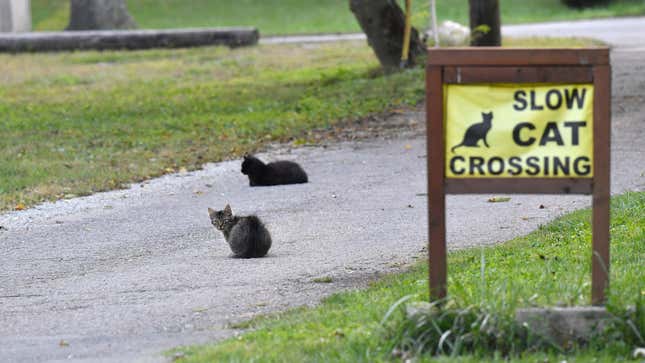
New research shows the extent to which cats are likely driving the spread of a problematic brain parasite to wild animals and how the ongoing deterioration of our environment is making this problem even worse.
A study published in Proceedings of the Royal Society B: Biological Science connects densely populated urban areas with increased cases of Toxoplasma gondii among wild mammals. Domestic cats are common carriers of the parasite, and cats are often allowed to freely roam outside, so the researchers naturally suspect our feline friends as being the driving mechanism behind this process. Veterinarian and ecologist Amy Wilson from the University of British Columbia led the new research.
Toxoplasma gondii is a parasite that causes an upsettingly common infection known as toxoplasmosis, or toxo; it infects approximately one-third of the world’s population. The parasite is famous for altering the behavior of mice, making them more susceptible to predation by cats. Once infected, a single cat can shed half-a-billion toxo eggs in just two weeks. These eggs, known as oocysts, are super resilient, capable of living in moist soil and water for a full year and possibly even longer.
Scientists refer to toxo as a generalist zoonotic parasite, which means it’s highly capable of living and spreading to all sorts of different animals. For toxo, this means it can make the leap to any warm-blooded animal, including birds and mammals. For healthy animals, a toxo infection shouldn’t be a problem, but when in the presence of a weakened immune system, the parasite goes into action, triggering all sorts of illnesses and death in some extreme cases. In humans, the disease is especially dangerous for pregnant people.
Going into the study, Wilson and her colleagues knew that toxo isn’t spread evenly among the world’s wild animals, but the processes driving this variation were not well understood. The new study was an attempt to fill this gap in our knowledge. To that end, the team analyzed 45,079 documented cases of toxo in free-ranging wild mammal species. This data was pulled from 202 international studies and included 238 different mammalian species.
The connection became clear: Wildlife living near dense urban areas were more likely to be infected with toxo, and it didn’t matter where these animals were positioned within their respective food webs.
“For a species that is living in a high human density area, the risk of toxoplasmosis is approximately three to four times greater than for a species living in a low human density area,” Wilson wrote in an email to Gizmodo.
The researchers also noticed a higher prevalence of the parasite in warmer climates and among animals with aquatic diets. “Any warm-blooded mammal can be infected, but we found that species in aquatic habitats tended to have higher infections, presumably through exposure to contaminated water,” Wilson said.
Got a couple of caveats to point out, however.
The researchers didn’t have the desired global coverage, lacking data for central Eurasia and east-central Africa. That’s unfortunate, because “countries on these continents have relatively high human T. gondii prevalence,” according to the paper. Also, the team would like to dive deeper into the various ecosystems studied, to get a more nuanced sense of where and how toxo might be spreading within the identified hotspots.
The paper identifies high-risk areas for wild animals to acquire a toxo infection, but as the researchers themselves admit, cause and effect was not firmly established; the scientists are merely inferring that cats are the primary drivers of the disease, which, to be fair, is probably a very good inference. Accordingly, “proactively targeting pathogen pollution from domestic cats would be the most pragmatic and impactful intervention for decreasing wildlife infections,” the authors write.
Ooh, that is such a good term: ‘pathogen pollution.’ That’s a nice way of describing the problem. We are literally polluting the environment with the toxo parasite by allowing some cats—a creature moulded by the processes of artificial selection and now reproducing to impossibly high numbers—to roam free. It’s well documented that domestic cats, when allowed to roam free, are an ecological menace, killing huge numbers of birds and other creatures; we can now add another item to the list, as likely spreaders of toxo to wildlife.
An important point made in the paper is that vibrant and healthy ecosystems are a natural defense mechanism against the spread of pathogens, toxo included. “Healthy landscapes with different species of vegetation, soil bacteria, and invertebrates work together to filter out or inactivate disease organisms, essentially taking them out of circulation where they could infect wildlife or humans,” wrote Wilson in her email.
Conscientious cat owners can do a few things to reduce toxo spread and exposure. “Absolutely no one needs to rehome their cat—change the litter box every few days and don’t allow your cat outside unsupervised to hunt wildlife,” Wilson said. “Cats killing wildlife is a major conservation problem but also increases the risk that a cat will be infected by parasites that they can spread to both wildlife and humans. Importantly, toxoplasmosis is not only a risk to cat owners but anyone that accidentally comes in contact with something contaminated with infected cat feces. For example, researchers are finding Toxoplasma in the soil in playgrounds and parks, so this is really is a health issue for everyone.”
This article has been updated with comments from Amy Wilson.